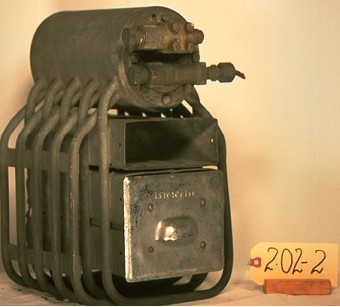Refrigerating and Air Conditioning Evaporators – Commercial
Three tray, ice maker evaporator with low-side float, using an early form of modular design and construction, made in tinned copper tube and brake formed copper sheet. Cooling unit and icemaker for small commercial cabinet refrigerator, Frigidaire, 1926.
Of special interest is the “building block” construction design technique adopted here. An early example of modular construction concept, the design allows additional ice cube tray slide in boxes to be added for constructing larger capacity cooling units (See items 023,024, 025). By the use of modular construction it was possible to “grow an ice maker evaporator, and that is exactly what was done – as items 023, 024, and 025 demonstrate. Considerable economy in manufacture and assembly was possible, with predictable performance.Note the attention to the design of the lower tray box, constructed to be used as a deep drawer or for bulk frozen food, it would double as a 2 tray ice cube maker by sliding in a metal divider shelf
Technical Significance:
See background notes on technological significance of early mechanical cooling units (evaporator), THOC-HVACR inventory item 011.This specimen is representative of the proliferation of models and sizes of low-side float operated evaporators of the period, largely by Kelvinator and Figidaire, as they attempted to stretch this making technology to its limit. Dinosaur like, costly, complicated and trouble prone by comparison with the evaporator technologies that would shortly follow, this genre would largely disappear from manufacture’s catalogues by the early 1930’s, although would be operational in the field until after WWII.
To contrast the weight, size, seeming complexity, as well as materials and manufacturing costs with the technology reflected in inventory items 015 to 021 is instructive. The classic process of progressive simplification in technological innovation and change is well exemplified.
Industrial Significance:
With complex, demanding construction, the evaporator would make many demands on manufacturing and materials engineering in the early years of the 20th century.


